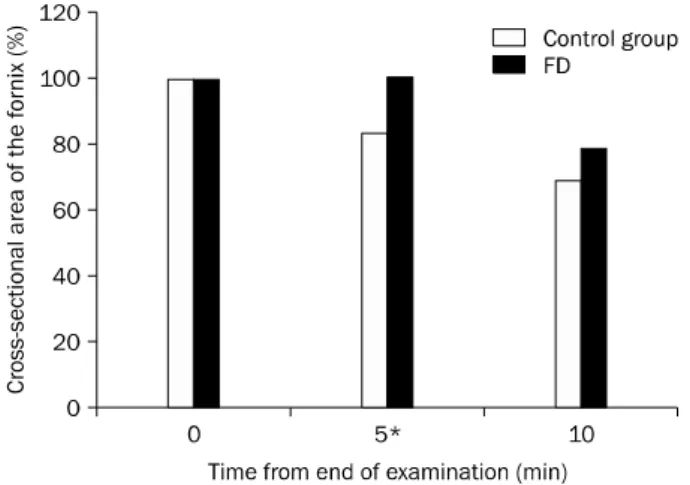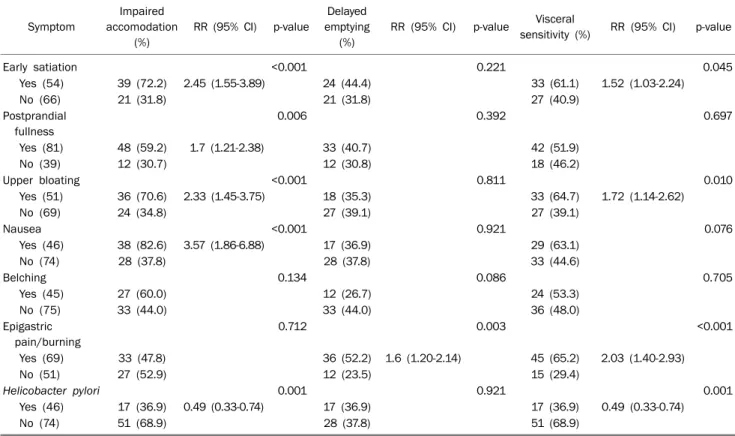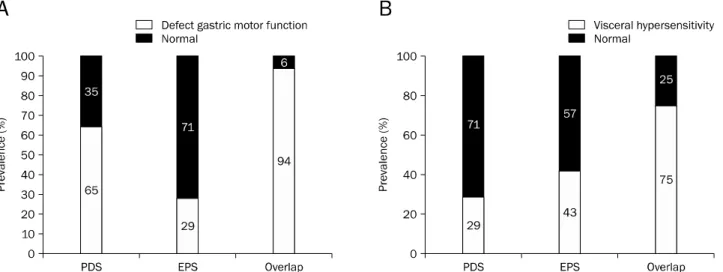ORIGINAL ARTICLE
Received February 24, 2015. Revised June 24, 2015. Accepted July 6, 2015.
CC This is an open access article distributed under the terms of the Creative Commons Attribution Non-Commercial License (http://creativecommons.org/licenses/
by-nc/4.0) which permits unrestricted non-commercial use, distribution, and reproduction in any medium, provided the original work is properly cited.
Copyright © 2015. Korean Society of Gastroenterology.
The editorial for this article was published on 67 page in this issue.
Correspondence to: Tatyana Kugler, Department of Internal Medicine, Bogomolets National Medical University, 03189, Lomonosova 52a str., app.141, Kyiv, Ukraine.
Tel: +38-050-1414080, Fax: +38- 050-1414080, E-mail: kugler2@mail.ru Financial support: None. Conflict of interest: None.
The Usefulness of Water-drinking Ultrasonography Combined Test for Evaluating Patients with Functional Dyspepsia
Tatyana Kugler
Department of Internal Medicine, Bogomolets National Medical University, Kyiv, Ukraine
Background/Aims: The major causes of functional dyspepsia (FD) are motility dysfunction and visceral hypersensitivity. Despite the large number of diagnostic tests, there are no convenient methods for evaluation of gastric functions. Therefore, this study was conducted to assess the relationship between the degree of dyspepsia and gastric accommodation, emptying, and sensitivity.
Methods: A total of 120 FD patients that met the Rome III criteria and 30 healthy volunteers were included in this cross-sectional study. The mean cross-sectional area of the fornix was measured to investigate fundic accommodation and gastric emptying during and after water intake. During the test, abdominal symptoms were evaluated using the 4-point Likert scale.
Results: The water-drinking ultrasonography combined test revealed impairment of gastric accommodation in FD after 1,000 mL of water intake, delayed emptying after 5 min of water intake and statistically significant hyperesthesia after 400 mL of water intake in the FD group compared with healthy controls (p<0.05). Postprandial distress syndrome (PDS) and overlap syndrome were independently associated with gut motor disturbances instead of epigastric pain syndrome (EPS) (p<0.01).
Conclusions: The results of the present study suggest that the water-drinking ultrasonography combined test could be used for diagnosis of gastric motor and sensory dysfunction, particularly in PDS and EPS-PDS patients. This test is easy, well tolerated by the patient and can be widely applied in clinical practice. (Korean J Gastroenterol 2015;66:92-97)
Key Words: Accommodation; Gastric emptying; Visceral hypersensitivity; Early satiation
INTRODUCTION
Functional gastrointestinal disorders are a common prob- lem in modern gastroenterology. Dyspepsia occurs in the same structural and functional pathology. According to Suzuki and Moayyedi1 upper gastrointestinal endoscopy findings appear normal in approximately 75% of patients with dyspepsia, and most of these individuals are diagnosed with functional dyspepsia (FD). FD is extremely common, in- fluencing 15-20% of the population, and is associated with a marked decrease in quality of life and substantial health-care costs.2 Understanding the particular qualities of FD patients provides important information concerning the various factors affecting consultation choice, which will clar-
ify the etiology of FD patients.3
FD is determined based on the presence of dyspeptic symptoms in the absence of any organic cause that can ex- plain them. The Rome III consensus divides FD into post- prandial distress syndrome (PDS) and epigastric pain syn- drome (EPS). Epidemiological studies in the United States and Europe confirmed the presence of both subgroups, with great overlap between EPS and PDS.4 The available treat- ment options for FD are of limited effectiveness, which re- flects its poorly understood pathogenesis. Studies indicate that FD is a heterogeneous disorder in which different patho- physiological mechanisms underlie specific symptom pat- terns.5 Traditionally, gut abnormalities such as impaired ac- commodation, delayed emptying and hypersensitivity are be-
lieved to be involved in the pathophysiology of FD.2 Tests of motility and sensory gastric functions are available in health service, but there is no gold standard. Gastric barostat is not widely used because the procedure is extremely invasive.6 The results of electrogastrography are dependent on the lo- cation of electrodes, acid secretion or duodenal reflux. Ima- ging methods such as X-ray and scintigraphy with 99Tc or 111In cannot be extensively applied because of radiation ex- posure and long examination time. Video capsule endoscopy is a very expensive method that is not applicable in routine practice. 13C-urea breath tests for evaluation of gastric emp- tying are only available in specialized clinics.7 Conversely, ul- trasonography does not require radiation, expensive chem- ical substances or unusual equipment. In terms of money and timesaving, the water-drinking ultrasonography com- bined test (WDUCT) is useful for examination of FD patients.6
SUBJECTS AND METHODS
1. Protocol
This cross-sectional study was conducted in the Depart- ment of Internal Medicine, Central Clinical Hospital No. 3, Donetsk, Ukraine, between November 2013 and November 2014. The study protocol was approved by the Ethics commit- tee of the Central Clinical Hospital No. 3 on 11 November 2013 (No. 169), and carried out in accordance with the Declaration of Helsinki.
2. Subjects
This study included 120 patients with a diagnosis of FD.
Patients were divided into three groups according to the Rome III criteria based on responses to Russian language-va- lidated questionnaires from the Ukrainian Gastroenterology Association (member of World Gastroenterology Organisa- tion). Subjects were eligible to enter the study if all of the fol- lowing criteria were met: male or female subjects aged 18-75 years; Rome III Criteria fulfilled for the 3 months prior to in- formed consent with symptom onset at least 6 months prior to informed consent; normal endoscopy results within 6 months; female subjects of childbearing potential must pro- vide a negative pregnancy test. Exclusion criteria included:
subjects taking drugs that affect gut motility, gut sensitivity and/or acid secretion or NSAIDs; organic gastrointestinal dis- ease; history of surgery that can affect gastrointestinal mo-
tility including endoscopic surgery for gastroesophageal re- flux disease (GERD) and obesity; irritable bowel syndrome;
chronic idiopathic nausea; Type I or Type II diabetes; active uncontrolled psychiatric and/or psychosomatic disorders;
BMI over 30 kg/m2; clinically significant renal, hepatic, car- diovascular, pulmonary, endocrine, metabolic, or hemato- logical condition.
Healthy subjects did not have dyspepsia symptoms or drug allergy. All subjects recruited in the study were subjected to upper gastrointestinal endoscopy, biochemistry analyses and abdominal ultrasound to exclude organic alimentary tract diseases. Written informed consent was obtained from all study participants.
3. Procedures
During the water-drinking period, subjects ingested 200 mL of water at 3-min intervals five times (total 1,000 mL) by ingesting water through a straw. The test was discontinued if subjects felt any discomfort. Examination of gastric empty- ing was conducted 5 and 10 min after completion of drinking 1,000 mL of water (or discontinuation). The mean cross-sec- tional area of the fornix during and after water intake was measured to investigate the fundic accommodation and gas- tric emptying. All ultrasonographic examinations were con- ducted using an Ultima PA (1-5 MHz convex-type probe;
Radmir, Kharkiv, Ukraine). The patient was asked to grade the intensity (0, absent; 1, mild; 2, relevant; and 3, severe) of the pain during water intake.
4. Statistical analysis
Data were evaluated with Medstat (Donetsk, Ukraine), which is a commercially available statistical analysis soft- ware package. All values were expressed as the mean±SD.
The normal range of the cross-sectional area of the fornix was set using dates of 30 healthy volunteers. Cases outside the normal range were diagnosed with a motor or sensory disorder. Student’s t-test and Wilcoxon’s tests were con- ducted to evaluate continuous variables and the chi-squared test was used to measure frequency variables. p-values of less than 0.05 were considered to indicate statistical significance. RR with a 95% CI was computed. Biochemical re- sults displayed normal distribution.
Fig. 1. Impairment of gastric accommodation in the functional dyspepsia (FD) patients. *p=0.031.
Fig. 2. Delayed emptying in the functional dyspepsia (FD) patients.
*p=0.002.
Fig. 3. Visceral hypersensitivity in the functional dyspepsia (FD) patients. *p=0.047.
Table 1. Gastric Accommodation and Visceral Hypersensitivity in Healthy Subjects and Functional Dyspepsia (FD) Patients
Water intake (mL)
Gastric accommodation (cm2) Visceral hypersensitivity
FD Control FD Control
0 8.98±1.8 8.64±1.78 0 0
200 11.9±2.1 12.21±2.94 0.4±0.63 0.1±0.31 400 15.76±2.14 18.57±4.6 0.8±1.01 0.1±0.31*
600 21.37±3.0 25.75±5.92 1.4±1.05 0.2±0.42 800 25.7±4.21 31.21±7.69 1.53±1.12 0.2±0.42 1,000 29.34±4.9 34.92±7.2* 1.8±1.08 0.3±0.48
*p<0.05.
RESULTS
1. Demographics
The first group consisted of 56 (46.7%) patients with PDS, the second contained 44 (36.7%) patients with overlapping EPS and PDS, and the third 20 (16.7%) patients with EPS. The age limits of the patients were 18-67 years (mean age 39.4±4.3 years). The study group consisted of 41 men (34.2%) and 79 women (65.8%). The mean BMI of the group was 24.8±6.3 kg/m2. The healthy control group consisted of 30 subjects (14 males and 16 females) with a mean age of 39.2±14.8 (18-59) years and a mean BMI of 22.8±4.3 kg/m2. There was no significant difference between groups in the distribution of sex, age, BMI, height and weight.
2. Gastric accommodation
We developed a novel WDUCT to assess gastric motility and sensory functions of FD patients compared with healthy controls. First, we studied gastric accommodation (Fig. 1).
The values of the mean cross-sectional area of the fundus be- fore and after intake of 200, 400, 600, 800, and 1,000 mL of water in the control and FD groups were expressed in Table 1. The mean cross-sectional area of the fundus after intake of 1,000 mL of water was significantly lower in the FD group, suggesting impairment of the gastric accommodation in FD.
3. Gastric emptying
We also experienced delayed emptying in the FD group (Fig. 2). The percentage of the cross-sectional area of the fun- dus after 5 min was 100.4±15.1% in the FD group and 83.47±8.44% in the control (p=0.002). The percentage of the cross-sectional area of the fornix after 10 min was 78.2±16.7%, while it was 69.4±8.8% in the control group, (p=0.131). The mean value of the cross-sectional area of the fundus 5 min after drinking water in the FD group was higher
Table 2. Symptoms and Results of Water-drinking Ultrasonography Combined Test
Symptom
Impaired accomodation
(%)
RR (95% CI) p-value
Delayed emptying
(%)
RR (95% CI) p-value Visceral
sensitivity (%) RR (95% CI) p-value
Early satiation <0.001 0.221 0.045
Yes (54) 39 (72.2) 2.45 (1.55-3.89) 24 (44.4) 33 (61.1) 1.52 (1.03-2.24)
No (66) 21 (31.8) 21 (31.8) 27 (40.9)
Postprandial fullness
0.006 0.392 0.697
Yes (81) 48 (59.2) 1.7 (1.21-2.38) 33 (40.7) 42 (51.9)
No (39) 12 (30.7) 12 (30.8) 18 (46.2)
Upper bloating <0.001 0.811 0.010
Yes (51) 36 (70.6) 2.33 (1.45-3.75) 18 (35.3) 33 (64.7) 1.72 (1.14-2.62)
No (69) 24 (34.8) 27 (39.1) 27 (39.1)
Nausea <0.001 0.921 0.076
Yes (46) 38 (82.6) 3.57 (1.86-6.88) 17 (36.9) 29 (63.1)
No (74) 28 (37.8) 28 (37.8) 33 (44.6)
Belching 0.134 0.086 0.705
Yes (45) 27 (60.0) 12 (26.7) 24 (53.3)
No (75) 33 (44.0) 33 (44.0) 36 (48.0)
Epigastric pain/burning
0.712 0.003 <0.001
Yes (69) 33 (47.8) 36 (52.2) 1.6 (1.20-2.14) 45 (65.2) 2.03 (1.40-2.93)
No (51) 27 (52.9) 12 (23.5) 15 (29.4)
Helicobacter pylori 0.001 0.921 0.001
Yes (46) 17 (36.9) 0.49 (0.33-0.74) 17 (36.9) 17 (36.9) 0.49 (0.33-0.74)
No (74) 51 (68.9) 28 (37.8) 51 (68.9)
Fig. 4. Prevalence of dyspeptic symptoms and Helicobacter pylori (%) in patients diagnosed with normal and impaired gastric accommo- dation.
than that in the control group, suggesting delayed emptying in FD.
4. Visceral hypersensitivity
In the FD group, marked symptoms such as abdominal full- ness and epigastric pain developed immediately after the ini- tiation of water intake, and the Likert scale was higher than the controls (Fig. 3). The Likert scale differed significantly be- tween the control and FD groups after ingestion of 400 mL (after 200 mL of water 0.4±0.63 vs. 0.1±0.31, p=0.189;
after 400 mL 0.8±1.01 vs. 0.1±0.31, p=0.047; after 600 mL 1.4±1.05 vs. 0.2±0.42, p=0.004; after 800 mL 1.53±1.12 vs. 0.2±0.42, p=0.04; after 1,000 mL 1.8±1.08 vs. 0.3±
0.48, p=0.02), suggesting hyperesthesia in the FD group.
5. Relationship between symptoms and results of WDUCT Comparison of the prevalence of individual symptoms in subjects with normal and reduced accommodation, normal and delayed gastric emptying, and normal and hyper- sensitivity are summarized in Table 2. This study has re- vealed connections between dyspeptic symptoms and gut motor function. Impairment of accommodation was found in
50.0% of FD patients and was typical for patients with post- prandial symptoms, p<0.001 (Fig. 4). Delayed gastric emp- tying was typical for 37.5% of the FD patients and 52.2% of patients with epigastric pain. This type has hyperacid pH-
Fig. 5. Comparison of the prevalence defect motor gastric function (A) and visceral hypersensitivity (B) in patients with different functional dyspepsia subtypes using the χ2-test. Postprandial distress syndrome (PDS) and overlap have defective accommodation and/or significantly higher frequency of emptying than epigastric pain syndrome (EPS) (p<0.05). Visceral hypersensitivity is increased in overlap relative to PDS (p<0.001).
gram frequently. It is assumed that acidification of the duode- num promotes mechanisms such as impaired gastric accom- modation, delayed gastric emptying and hypersensitivity, which contributes to the appearance of symptoms. Visceral hypersensitivity occurred in half of the FD individuals and pre- vailed among patients with early satiety (p=0.045), bloating (p=0.010) and pain (p<0.001). The disturbances of gastric motor-evacuation function were dependent on the clinical subtype of FD (Fig. 5). Impairment of the accommodation and/or emptying were encountered more frequently in the PDS and overlap group than in the EPS, p<0.05. Visceral hy- persensitivity prevailed in the overlap group (p<0.001).
DISCUSSION
The pathophysiological mechanisms of FD include gastro- intestinal dysmotility, perception disturbance, acid hyper- sensitivity, psychological factors, duodenal dysfunction, and abnormalities within the brain-gut axis. WDUCT revealed ab- normalities in gastric motility and sensation in patients with FD when compared with healthy controls. However, most di- agnostic tests of gastric motility only characterize gastric emptying. Therefore, we investigated the relationship be- tween accommodation and postprandial symptoms.
Several studies have reported that the prevalence of im- paired gastric accommodation in patients with FD is around 40-60%, whereby proximal adequate relaxation occurs.8 The
origin of impaired accommodation in FD is not know, but it is likely caused by abnormalities of the vago-vagal reflex, the in- trinsic inhibitory innervation (myenteric plexus) or smooth muscles of the proximal stomach.2 Delayed gastric emptying also plays an important role in the pathogenesis of FD. De- pending on the different study design, the prevalence ranges from 20% to 50%.2,9 Visceral hypersensitivity to gastric dis- tension is detected in 34-65% of patients with FD and corre- lated with the severity of dyspeptic symptoms.8 Van Ouden- hove et al.10 first found a significant and independent influ- ence of gastric sensitivity and abuse history on gastric sensa- tion scores in FD. Additionally, brain imaging revealed differ- ences in the activity of homeostatic-afferent, emotional- arousal and cortical-modulatory regions, most of which are involved in cognitive/affective aspects of visceral pain.
FD is one of the most common gastrointestinal disorders encountered in clinical practice. Keeping in mind the high hu- man and economic burden, more effective treatment is badly needed. The wide variety of FD symptoms indicates multiple pathophysiological mechanisms. Progress in its under- standing might lead to better symptom control through the development of targeted therapy.2 Impaired accommodation of the proximal stomach has been observed in FD, but its rele- vance to postprandial symptoms is unclear. We demon- strated that impaired gastric accommodation causes early satiety, postprandial fullness, bloating and nausea, but not delayed gastric emptying. Despite the large number of proki-
netic agents represented in our market, they are assigned blindly because physicians do not know about modification of gastric motility during treatment. The WDUCT can be read- ily performed, is well tolerated and widely applied in routine clinical practice. However, further studies are necessary to clarify the strategy of FD treatment. Promotion of gastric ac- commodation may be an effective therapy for patients with FD who report early satiety and postprandial fullness.
ACKNOWLEDGEMENTS
I thank my supervisor Professor Dorofeyev AE for his con- tributions to this work and the ultrasound department of Central City Clinical Hospital No. 3 for their technical support.
REFERENCES
1. Suzuki H, Moayyedi P. Helicobacter pylori infection in functional dyspepsia. Nat Rev Gastroenterol Hepatol 2013;10:168-174.
2. Vanheel H, Farré R. Changes in gastrointestinal tract function and structure in functional dyspepsia. Nat Rev Gastroenterol Hepatol 2013;10:142-149.
3. Shimpuku M, Futagami S, Tajima N, et al. Impact of eating atti-
tude and impairment of physical quality of life between tertiary clinic and primary clinic functional dyspepsia outpatients in Japan. J Neurogastroenterol Motil 2014;20:506-515.
4. Tack J, Talley NJ. Functional dyspepsia--symptoms, definitions and validity of the Rome III criteria. Nat Rev Gastroenterol Hepatol 2013;10:134-141.
5. Tack J, Bisschops R, Sarnelli G. Pathophysiology and treatment of functional dyspepsia. Gastroenterology 2004;127:1239- 1255.
6. Kato M, Nishida U, Nishida M, et al. Pathophysiological classi- fication of functional dyspepsia using a novel drinking-ultra- sonography test. Digestion 2010;82:162-166.
7. Shvets NI, Bentsa TM. [Dysmotility syndrome of the upper gastro- intestinal tract in the clinical practice: diagnosis and treatment].
News Med Pharm 2010;323. Available from: http://www.mif-ua.
com/archive/article_print/12538. Ukrainian.
8. Ivashkin VT, Sheptulin AA, Lapina TL, et al. Guidelines of the Russian Gastroenterological Association on diagnostics and treatment of functional dyspepsia. RZHGGK 2012;22:80-92.
9. Kim DY, Delgado-Aros S, Camilleri M, et al. Noninvasive meas- urement of gastric accommodation in patients with idiopathic nonulcer dyspepsia. Am J Gastroenterol 2001;96:3099-3105.
10. Van Oudenhove L, Vandenberghe J, Dupont P, et al. Regional brain activity in functional dyspepsia: a H(2)(15)O-PET study on the role of gastric sensitivity and abuse history. Gastroenterolo- gy 2010;139:36-47.


